Somali cats are far more than just the sum of their parts. This is a lively, beautiful, intelligent cat who revels in the company of humans and animals alike.
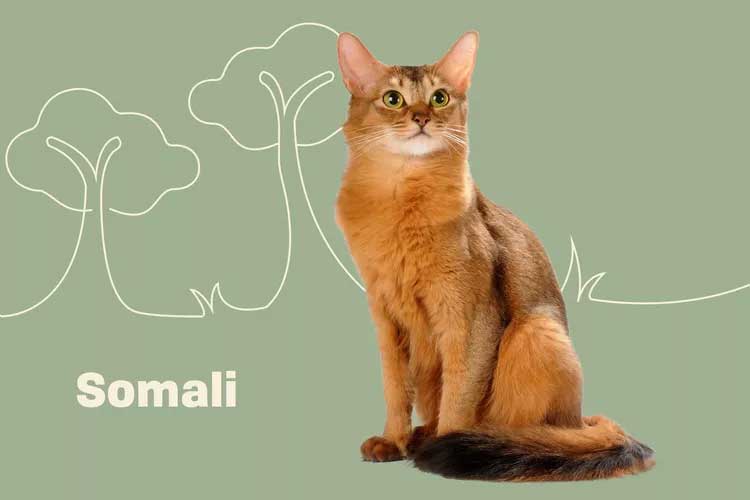
Somali Overview
| OFFICIAL NAME | Somali |
| COMMON NAME | Somali |
| PET HEIGHT | 7 to 11 inches |
| PET WEIGHT | 6 to 10 pounds |
| LIFESPAN | 11 to 16 years |
| GOOD WITH | cats, children, dogs, families, seniors |
| TEMPERAMENT | bold, sociable |
| INTELLIGENCE | high |
| SHEDDING AMOUNT | frequent |
| PLAYFULNESS | high |
| ENERGY LEVEL | hyper |
| VOCAL LEVEL | when necessary |
| COAT LENGTH | long |
| COLORS | blue / gray, cinnamon, fawn, red / orange |
| PATTERNS | solid |
| OTHER TRAITS | easy to train, friendly toward humans, friendly toward other pets, friendly toward strangers, requires lots of grooming |
Considering the Somali's origin story, it can be easy to write off these beautiful cats as "just" a long-haired Abyssinian. But as any Somali cat owner will tell you, there's so much more to the story.
"The Somali is an incredible breed," says Dianne Taylor, secretary of the Somali Cat Club of Great Britain. "They are very sociable and are the perfect family pet."
Somalis are brilliant, gregarious, tirelessly active cats who delight in learning tricks, bonding with humans and other animals alike, and exploring every inch of their environments. Delightfully curious and playful, the Somali cat will be a lifelong friend and companion who will do her best to ensure you never have a dull moment.
Appearance
The Cat Fanciers' Association breed standard recognizes four Somali coat colors: red, ruddy, fawn, and blue. Internationally, there are some breeders who trade in Somalis with other colors including tortoiseshell ticked or tabby ticked coats, but those are rare and not generally recognized by most breeders or breed associations.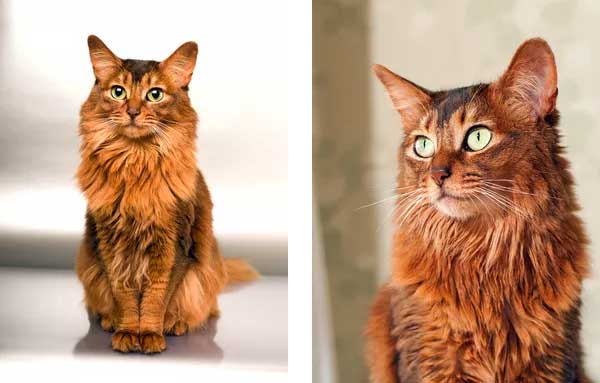
In most other regards, the Somali's coat mimics that of the Abyssinian cat, just with long hair (but, Taylor says, there are short-coated Somalis whose coats are denser than an Aby's). Both breeds have the same ticking, with individual hairs having bands of alternating color from root to tip. Most Somalis are found in the ruddy or orange/red color range that, along with their bushy tails, has caused people to nickname them "fox cats."
Somalis are medium-large cats—the average weight of a Somali cat is usually 6–10 pounds—with large almond eyes, large pointed ears, and bold facial markings that are another hallmark of the breed.
Temperament
Prepare to have your life monopolized. The Somali is not for the faint of heart or for anyone looking for a quiet, docile lap cat. These guys are always on the move and always looking to be the center of attention. Teach the Somali to fetch at your own peril, because once they understand the game, they are never going to want to stop."I always say they are the cat breed that's the nearest to a dog in their behavior," Taylor says. "They will follow their owners, retrieve toys, and be a constant companion. You can't do a job without the Somali either supervising or trying to help."
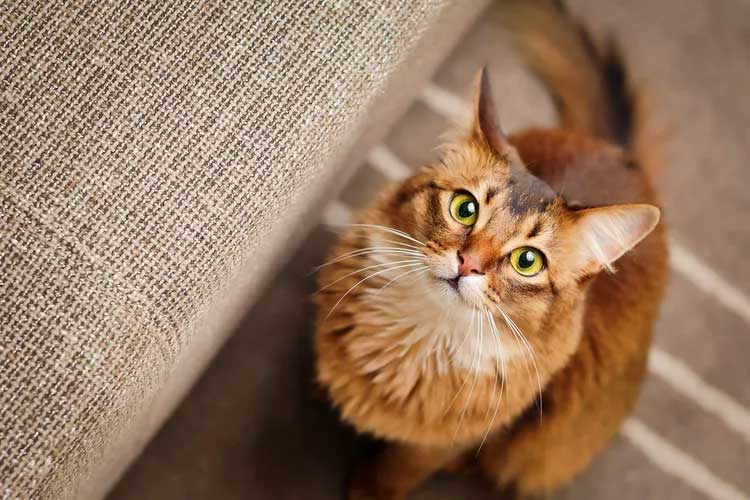
Because they are so rambunctious and so smart, making sure that a Somali's exercise needs are met is an important part of keeping her happy and motivated. Structured playtime is also an excellent bonding experience.
"The most important thing for the cats is to keep them active," says Carol Margolis, DVM, DACT, of the Gold Coast Center for Veterinary Care on Long Island, NY. "People think they can just wave a wand around, but the real bonding part of owning a cat is doing the running around and being the prey toy. If you're not panting a little bit, you're not playing with them enough."
The Somali can (and probably will) make a toy out of anything light enough to bat around. Ping-pong balls, pieces of paper, twist ties—it's all fair game. They are also excellent climbers, explorers, and snoopers. They are dexterous enough to figure out how to open cabinets and doors, and some have even been known to learn to turn on water faucets for a nice splash.
The Somali is a very intelligent cat who learns tricks well and loves to perform and be the center of attention.
"Nothing is a better sight than a happy Somali with her tail held high waving like a banner, chirruping as she runs along," Taylor says. "They are very active cats and never seem to slow, whatever their age."
Living Needs
The Somali is a very vertical cat. So if you aren't providing some ceiling-height cat trees, shelves, condos, and hammocks for her to climb, she's going to find her way up to the highest point in the room, be it a bookshelf, door top, or refrigerator.
Due to their incredibly social nature, they are not cats that you want to leave on their own for too long, Taylor says. Left home alone with no playmates, the Somali is likely to develop separation anxiety. Whenever she is alone, she'll need access to interactive toys, scratching posts, and puzzles to keep her mind occupied.
These are also cats who get along with just about anyone else in the house, two-legged or otherwise. School-age kiddos are a great match for the Somali's big energy level and playfulness. Strangers are always welcome, as are other cats (especially Abyssinians or other Somalis), cat-friendly dogs, and even larger rodents like ferrets and rats.
Care
Brush, brush, brush. That's going to be the large and small of it when it comes to keeping your Somali happy. Their long, silky hair sheds regularly, and that only gets heavier in the summer months as they lose some of that winter coat bulk. Taylor says daily combing is a requirement. Additionally, thanks to that bushy, bushy tail, every trip to the litter box has the potential to turn your life into a "Star Trek" episode as you go exploring for cling-ons.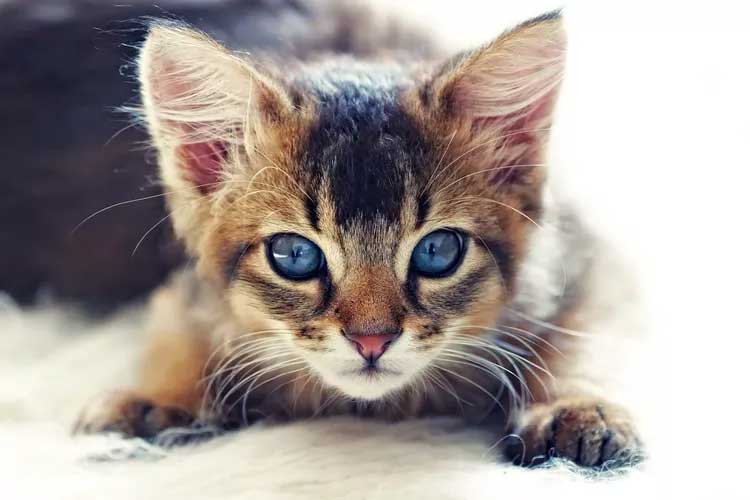
And, like all cats, your Somali needs her claws trimmed frequently, ears cleaned regularly, and her litter box kept tidy.
Health
Like their Abyssinian cousins, Somalis are a pretty healthy breed. Though, they are at risk of Pyruvate kinase deficiency (PKDef), an inherited disease that can cause anemia. To ensure you bring home a healthy Somali kitten, always work with a reputable breeder who gets their cats' health screened.That aside, the gamut of typical cat health issues like arthritis, heart disease, and kidney issues are all going to be things you and your vet will want to keep on eye on as your Somali ages. Periodontal diseases can be an issue as well, so keeping her teeth cleaned—including by a veterinarian every couple of months—can go a long way towards keeping your Somali happy and healthy.
History
As a recessive gene in the Abyssinian breed, long-haired Abys have been showing up for decades, if not longer, according to the CFA. For a long time, the long-haired kittens were disavowed by Aby breeders, quickly shuttled off to be pets instead of show cats.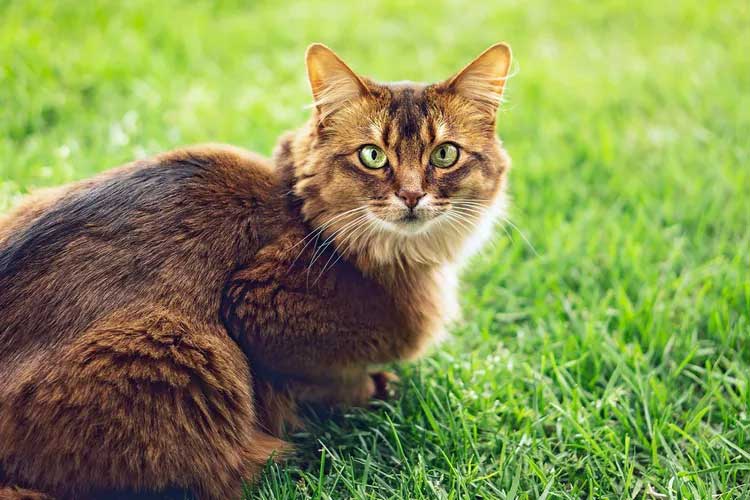
How the long-haired gene was first introduced into the Abyssinian bloodline is a matter of much debate and speculation. Similarly, who first started breeding long-haired Abys is a matter largely lost to time. But what is not up for debate is that it was an American named Evelyn Mague who gave the Somali breed its name and made the first strides at getting the cat recognized as a separate breed by cat fancier clubs; something that was achieved in 1979, when the CFA recognized the breed for champion status.
Fun Facts
Not actually from Somalia, the name Somali was chosen because of the breed's close genetic connection to the Abyssinian. Somalia borders Abyssinia (modern day Ethiopia), and the symbolic connection seemed perfect to breeders.Errol the Somali cat is touted as a foxy stealer of hearts on Instagram, where this handsome guy has more than 100,000 followers.